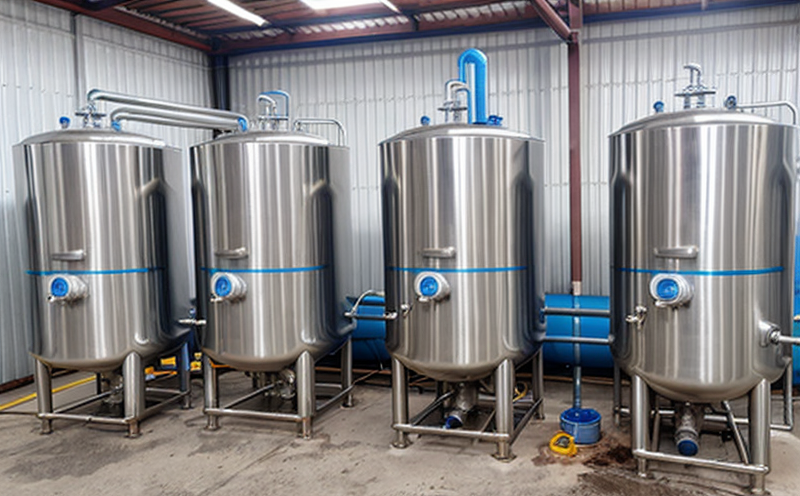ASTM D4191 Dissolved Gas Oxygen Nitrogen Carbon Dioxide Test in Boiler Water
The ASTM D4191 test method is a critical procedure used to determine the dissolved gases present in boiler water, specifically oxygen (O2), nitrogen (N2), and carbon dioxide (CO2). This analysis helps ensure that boilers operate efficiently and safely by maintaining optimal levels of these key constituents. Dissolved gas content directly influences the corrosion rate, water quality, and overall performance of boiler systems.
The test is particularly important in sectors like power generation, where large-scale industrial boilers are used to produce steam for electricity generation. Proper management of dissolved gases can reduce maintenance costs, extend equipment life, and enhance operational efficiency. In this context, ASTM D4191 provides a standardized method that ensures accurate and reliable results.
The primary goal of the ASTM D4191 test is to measure the partial pressures of each gas in the boiler water sample. This information is critical for identifying potential issues such as oxygen-induced corrosion or excessive nitrogen levels, which can lead to operational inefficiencies. The test involves several steps, including sampling, conditioning the water, and measuring the dissolved gases using a gas chromatograph.
The ASTM D4191 standard specifies the use of a gas-tight container for collecting the sample to prevent any loss of dissolved gases during transportation and analysis. Once the sample is collected, it must be transported to a laboratory equipped with a gas chromatography system capable of detecting trace amounts of these gases.
The test procedure itself involves conditioning the water at room temperature before measuring the partial pressures of O2, N2, and CO2. The results are expressed in millibars (mbar) or kilopascals (kPa), providing a clear indication of the dissolved gas content. These measurements are then used to evaluate the boiler water quality and determine if any corrective actions are necessary.
The importance of this test cannot be overstated, especially in industries where boiler performance directly impacts production efficiency and safety. By adhering to ASTM D4191, laboratories can ensure that their clients receive accurate and reliable results, which can help prevent costly downtime and maintenance issues.
Industry Applications
| Industry Sector | Application |
|---|---|
| Power Generation | Ensuring optimal boiler performance and preventing corrosion. |
| Chemical Processing | Maintaining water quality in large-scale industrial boilers. |
| Pharmaceutical Manufacturing | Safeguarding the integrity of equipment used in steam generation. |
| Food and Beverage | Guaranteeing consistent product quality by maintaining boiler efficiency. |
| Industry Sector | Application |
|---|---|
| Petrochemicals | Avoiding operational inefficiencies and ensuring safety in critical processes. |
| Biofuels | Optimizing the performance of boilers used in biofuel production. |
| Sewage Treatment | Maintaining proper water quality for efficient sewage treatment processes. |
| Textile Manufacturing | Ensuring consistent steam quality to enhance product quality and efficiency. |
The ASTM D4191 test is widely used across various industries where boiler systems play a crucial role in production processes. By adhering to this standard, laboratories can provide reliable data that helps clients make informed decisions about their equipment maintenance and operational strategies.
Quality and Reliability Assurance
The ASTM D4191 test is a cornerstone of quality assurance in boiler water management. By providing accurate measurements of dissolved gases, this standard helps ensure that boilers operate at their peak efficiency while minimizing the risk of operational failures. The use of standardized methods ensures consistency across different laboratories and testing facilities.
In addition to maintaining boiler performance, ASTM D4191 also plays a key role in preventing corrosion. Excessive oxygen levels can accelerate the corrosion process, leading to premature equipment failure and increased maintenance costs. By monitoring dissolved gas levels using this standard, operators can take corrective actions before issues become critical.
The reliability of the results generated by ASTM D4191 is further enhanced through regular calibration and validation of testing instruments. This ensures that all measurements are accurate and consistent with internationally recognized standards. Laboratories adhering to this method provide clients with confidence in the integrity of their test results.
Furthermore, the use of ASTM D4191 promotes best practices in boiler water management, ensuring compliance with industry regulations and safety guidelines. By following this standard, laboratories can help operators meet regulatory requirements and enhance overall safety standards within their facilities.
Customer Impact and Satisfaction
The ASTM D4191 test method has a direct impact on the performance and longevity of boiler systems. By providing accurate measurements of dissolved gases, this standard helps operators make informed decisions about their equipment maintenance and operational strategies. This leads to improved efficiency, reduced downtime, and lower maintenance costs.
Customers who use ASTM D4191 for their testing needs can expect high-quality results that are consistently reliable across different laboratories. The standardized approach ensures that all test results are comparable, allowing clients to compare data from various sources and make more informed decisions.
The reliability of the results generated by ASTM D4191 also contributes to increased customer satisfaction. By providing accurate and consistent measurements, this standard helps operators maintain their equipment in optimal condition, reducing the risk of operational failures. This translates into higher levels of customer satisfaction as clients can trust that they are receiving high-quality services.
In addition to improving efficiency and reliability, ASTM D4191 also enhances safety within facilities by helping prevent corrosion and other potential issues. By adhering to this standard, operators can ensure that their equipment is operating at peak performance levels, which contributes to a safer working environment for all employees.





